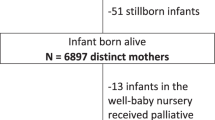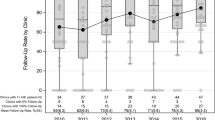Abstract
Objective
Investigate the association between maternal homelessness at the time of delivery and perinatal outcomes, with a focus on neonatal health outcomes.
Study design
Population-based cohort using California’s statewide database included 1,520,253 women with linked birth and maternal discharge data, 2008–2012. Multivariable analysis assessed homelessness at time of delivery on perinatal outcomes, preterm delivery, and neonatal intensive care unit admission.
Result
A total of 672 women (0.05%) were homeless at the time of delivery. Homelessness was associated with premature delivery at multiple gestational age cutoffs (34w0d–36w6d; 32w0d–33w6d; 28w0d–31w6d; <28w0d) (range of aORs:1.62–2.19), and neonatal intensive care unit admission (aOR = 1.66, 95% CI:1.31–2.09). Among term infants, homelessness remained associated with increased odds of neonatal intensive care unit admission (aOR = 1.84, 95% CI:1.34–2.53), low birthweight (aOR = 1.99, 95% CI:1.36–2.90), neonatal abstinence syndrome (aOR = 2.13, 95% CI:1.35–2.53), hypoxic-ischemic encephalopathy (aOR = 14.38, 95% CI:3.90–53.01), and necrotizing enterocolitis (aOR = 14.94, 95% CI:2.68–83.20).
Conclusion
Homelessness in pregnancy was associated with adverse perinatal outcomes including increased odds of preterm delivery across all gestational ages, and increased risk of neonatal intensive care unit admission and low birth weight independent of preterm delivery.
This is a preview of subscription content, access via your institution
Access options
Subscribe to this journal
Receive 12 print issues and online access
$259.00 per year
only $21.58 per issue
Buy this article
- Purchase on Springer Link
- Instant access to full article PDF
Prices may be subject to local taxes which are calculated during checkout

Similar content being viewed by others
References
Braveman P, Gottlieb L. The social determinants of health: it’s time to consider the causes of the causes. Public Health Rep. 2014;129:19–31.
Marmot M. Social determinants of health inequalities. Lancet. 2005;365:1099–104.
Braveman P, Egerter S, Williams DR. The social determinants of health: coming of age. Annu Rev Public Health. 2011;32:381–98.
Wilkinson RG, Marmot M. Social determinants of health: the solid facts: World Health Organization; 2003.
Bassuk EL, Weinreb LF, Buckner JC, Browne A, Salomon A, Bassuk SS. The characteristics and needs of sheltered homeless and low-income housed mothers. JAMA. 1996;276:640–6.
Henry M, Mahathey A, Morrill T, Robinson A, Shivji A, Watt R, et al. The 2018 Annual Homeless Assessment Report (AHAR) to Congress: Part 1: Point-in-time estimates of homelessness. Washington D.C.: Department of Housing and Urban Development, Office of Community Planning and Development; 2018. p. 100.
Creanga AA, Berg CJ, Syverson C, Seed K, Bruce FC, Callaghan WM. Race, ethnicity, and nativity differentials in pregnancy-related mortality in the United States: 1993–2006. Obstet Gynecol. 2012;120:261–8.
Luo Z-C, Wilkins R, Kramer MS. Effect of neighbourhood income and maternal education on birth outcomes: a population-based study. Cmaj. 2006;174:1415–20.
Kim D, Saada A. The social determinants of infant mortality and birth outcomes in Western developed nations: a cross-country systematic review. Int J Environ Res Public Health. 2013;10:2296–335.
Nkansah-Amankra S, Dhawain A, Hussey JR, Luchok KJ. Maternal social support and neighborhood income inequality as predictors of low birth weight and preterm birth outcome disparities: analysis of South Carolina Pregnancy Risk Assessment and Monitoring System survey, 2000–2003. Matern Child Health J. 2010;14:774–85.
Fazel S, Geddes JR, Kushel M. The health of homeless people in high-income countries: descriptive epidemiology, health consequences, and clinical and policy recommendations. Lancet. 2014;384:1529–40.
Wagner JD, Menke EM. Substance use by homeless pregnant mothers. J Health Care Poor Underserved. 1992;3:161–72.
Weinreb L, Goldberg R, Perloff J. Health characteristics and medical service use patterns of sheltered homeless and low-income housed mothers. J Gen Intern Med. 1998;13:389–97.
Pantell MS, Baer RJ, Torres JM, Felder JN, Gomez AM, Chambers BD, et al. Associations between unstable housing, obstetric outcomes, and perinatal health care utilization. Am J Obstet Gynecol MFM. 2019;1:100053. https://doi.org/10.1016/j.ajobmf.2019.100053.
Clark RE, Weinreb L, Flahive JM, Seifert RW. Homelessness contributes to pregnancy complications. Health Aff (Millwood). 2019;38:139–46.
Richards R, Merrill RM, Baksh L. Health behaviors and infant health outcomes in homeless pregnant women in the United States. Pediatrics. 2011;128:438–46.
Cutts DB, Coleman S, Black MM, Chilton MM, Cook JT, de Cuba SE, et al. Homelessness during pregnancy: a unique, time-dependent risk factor of birth outcomes. Matern Child Health J. 2015;19:1276–83.
Little M, Shah R, Vermeulen MJ, Gorman A, Dzendoletas D, Ray JG. Adverse perinatal outcomes associated with homelessness and substance use in pregnancy. CMAJ. 2005;173:615–8.
Paterson CM, Roderick P. Obstetric outcome in homeless women. BMJ. 1990;301:263–6.
Stein JA, Lu MC, Gelberg L. Severity of homelessness and adverse birth outcomes. Health Psychol. 2000;19:524–34.
Martin JA, Hamilton BE, Osterman MJK. Births in the United States, 2017. NCHS Data Brief. 2018;318:1–8.
Herrchen B, Gould JB, Nesbitt TS. Vital statistics linked birth/infant death and hospital discharge record linkage for epidemiological studies. Comput Biomed Res. 1997;30:290–305.
Severe Maternal Morbidity Indicators and Corresponding ICD Codes during Delivery Hospitalizations.Center for Disease Control; 2018 [updated December 13, 2018. Available from: https://www.cdc.gov/reproductivehealth/maternalinfanthealth/smm/severe-morbidity-ICD.htm.
Firth S. Bias reduction of maximum likelihood estimates. Biometrika. 1993;80:27–38.
Blencowe H, Cousens S, Chou D, Oestergaard M, Say L, Moller A-B, et al. Born too soon: the global epidemiology of 15 million preterm births. Reprod health. 2013;10:S2.
Clark RE, Weinreb L, Flahive JM, Seifert RW. Infants exposed to homelessness: health, health care use, and health spending from birth to age six. Health Aff (Millwood). 2019;38:721–8.
Crawford DM, Trotter EC, Hartshorn KJ, Whitbeck LB. Pregnancy and mental health of young homeless women. Am J Orthopsychiatry. 2011;81:173–83.
Bassuk EL, Buckner JC, Perloff JN, Bassuk SS. Prevalence of mental health and substance use disorders among homeless and low-income housed mothers. Am J Psychiatry. 1998;155:1561–4.
Robertson MJ, Winkleby MA. Mental health problems of homeless women and differences across subgroups. Annu Rev Public Health. 1996;17:311–36.
Zlotnick C, Zerger S. Survey findings on characteristics and health status of clients treated by the federally funded (US) Health Care for the Homeless Programs. Health Soc Care Community. 2009;17:18–26.
Riley AJ, Harding G, Underwood MR, Carter YH. Homelessness: a problem for primary care? Br J Gen Pract. 2003;53:473–9.
Skosireva A, O’Campo P, Zerger S, Chambers C, Gapka S, Stergiopoulos V. Different faces of discrimination: perceived discrimination among homeless adults with mental illness in healthcare settings. BMC Health Serv Res. 2014;14:376.
Bloom KC, Bednarzyk MS, Devitt DL, Renault RA, Teaman V, Van Loock DM. Barriers to prenatal care for homeless pregnant women. J Obstet, Gynecologic, Neonatal Nurs. 2004;33:428–35.
Author information
Authors and Affiliations
Contributions
BSS, AMS, LS, SAL, DS, AIG, GMS, and YYS contributed to the design and implementation of the research, to the analysis of the results and to the writing of the paper.
Corresponding author
Ethics declarations
Competing interests
The authors declare no competing interests.
Additional information
Publisher’s note Springer Nature remains neutral with regard to jurisdictional claims in published maps and institutional affiliations.
Supplementary information
Rights and permissions
About this article
Cite this article
St. Martin, B.S., Spiegel, A.M., Sie, L. et al. Homelessness in pregnancy: perinatal outcomes. J Perinatol 41, 2742–2748 (2021). https://doi.org/10.1038/s41372-021-01187-3
Received:
Revised:
Accepted:
Published:
Issue Date:
DOI: https://doi.org/10.1038/s41372-021-01187-3
This article is cited by
-
The Association between Psychosocial Stressors and Gestational Weight Gain: Analysis of the National Pregnancy Risk Assessment Monitoring System (PRAMS) Results from 2012 to 2015
Maternal and Child Health Journal (2024)
-
Improving Reproductive Health Communication Between Providers and Women Affected by Homelessness and Substance Use in San Francisco: Results from a Community-Informed Workshop
Maternal and Child Health Journal (2023)



